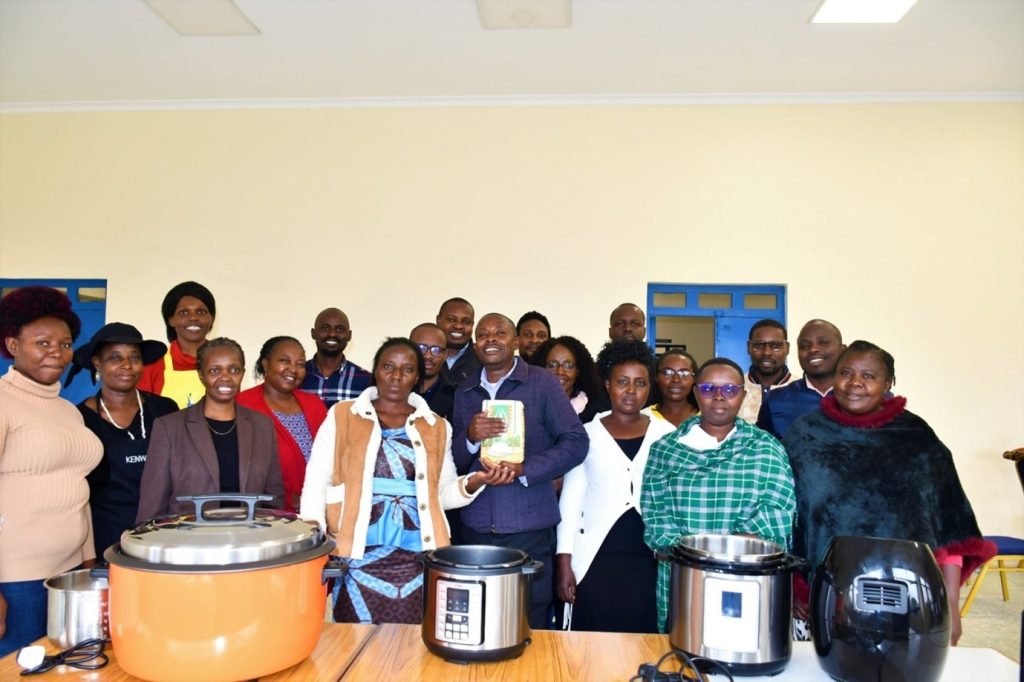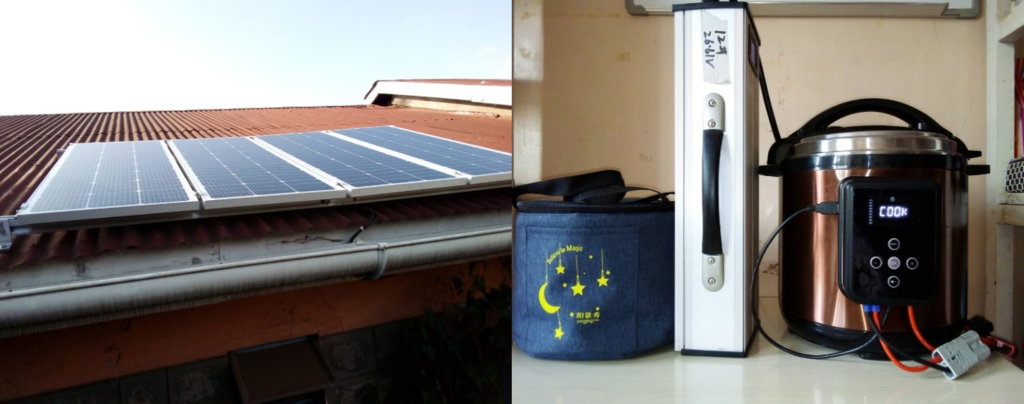
- Date
- 7th August 2023
- Categories
- Clean Cooking, Electric Cooking
By Emily Bolo, Africa Research and Impact Network (ARIN); Leonard Nyongesa, Village Infrastructure Angels Ltd (VIA); Daniel Gombe, Institute of Energy Studies & Research (IESR); Jon Leary, Gamos East Africa; Florence Onyango, Africa Research and Impact Network (ARIN), & Beryl Onjala, Gamos East Africa.
This blog highlights some of the issues that emerged, and lessons learned during the Pika na Power Academy. To date, Pika na Power has focused its activities in Nairobi. The recent establishment of the County e-Cooking Hubs has shown that there is potential for e-Cooking in many parts of the country. However, as e-Cooking is a new technology for many people, there is a need to build capacity at the local level to translate this potential into impact on the ground. Local champions have a key role to play in creating awareness, building supply chains, and developing business models that are tailored to the local context. The Pika na Power Academy aimed to offer aspiring e-Cooking champions the skills and experience they need to turn ideas into viable business opportunities that can accelerate the uptake of e-Cooking across the country.
Introduction
e-Cooking in Kenya is a relatively new concept and a choice that many households are less familiar with when compared to traditional cooking technologies and fuels. When the campaign about e-Cooking began some four years back in Kenya, it was not well received. It appeared to be unrealistic and issues such as unreliable electricity, affordability, and supply issues were pointed out to be the main barriers to the adoption of the technology. Currently, the total installed power in Kenya is 3.3GW while only 2.2GW is utilized. Despite the surplus in electricity generation, 42.16 million Kenyans still lack access to clean cooking technologies, a figure that could be reduced if e-Cooking is adopted. Though approximately 3% of Kenyans own electric cooking appliances, less than 1% use them as their main source of cooking fuel. The participants of the Pika na Power Academy were, therefore, challenged by the Director Institute of Energy Studies and Research, Dr. Jeremiah Kiplagat, to develop scalable business models that can enable the Kenyan population primarily using electricity to cook increase from 2% to 5% by the end of the year.
The Pika na Power Academy was delivered as a week-long residential course at KPLC’s Institute for Energy Studies and Research (IESR). The curriculum included a diverse array of subjects, including consumer financing; business models & business plan development; testing methods; live cooking demos; energy/power basics; e-Recipes & e-Cookbooks; overview of major appliance categories; energy-saving mechanisms; international supplier negotiation & importation procedures; after-sales service; repair/maintenance; household wiring assessments/upgrades; impact stories; business plan development; stakeholder engagement; marketing strategies; and kitchen energy audits. The programme also included time for networking and peer-to-peer engagement, to create a cohort of champions who can support each other to develop viable enterprises that can scale the adoption of e-Cooking across the country.

Factors Affecting the Adoption and Use of Electric Cooking Appliances
This section gives an overview of some of the major challenges that last-mile entrepreneurs face when marketing e-Cooking appliances.
Affordability
Affordability is a major constraint that hinders the adoption of clean cookstoves and more modern cooking devices such as energy-efficient e-Cooking appliances. Even those who have the financial means to buy, may not be willing to do so until they are convinced of the value it will add to their kitchen. To address the problem of affordability, various consumer financing models have been developed. Additionally, subsidies can be utilized to improve the affordability of e-Cooking appliances.
Distribution System
The e-Cooking production and supply systems are underdeveloped, and the market is still in its nascent stages. Besides, most consumers are not aware of the benefits of technology and may be inclined to think that it cannot meet all their culture-specific cooking needs. Therefore, the development of supply and demand factors is crucial in transitioning the technology from an emerging one to an established energy service. Reliability of supply is crucial as it will influence demand and guarantee the adoption and sustained use of electric appliances.
In the early stages of the electric cooking market, appliance shortages are common, and this qualifies as major market disruptors. Constraints in the supply chain are often due to inadequate policies needed to stimulate and sustain noticeable development. Currently, Kenya relies on imports for energy-efficient electric cooking appliances since it cannot produce them locally. As a result, fluctuations in prices, inflation of the local currency, and foreign exchange currency shortages may impact the supply of these products. Consequently, subsidies, financing programs, and structures that influence affordability and availability are key factors to consider.
After-sale Services
After-sale service is also another critical element that ensures the satisfaction and retention of customers. Apart from Sayona distributors, many EPC importers do not have the option of additional inner pots despite continuous requests from consumers. The non-stick coating tends to wear out easily and an extra pot can make it convenient to cook several dishes. Likewise, the appliances become obsolete if spare parts cannot be found to replace damaged ones.
Subsidy Allocation
The biggest players in the clean cooking market tend to receive the largest subsidies, which significantly influence the market dynamics. Such subsidies enable them to sell their products/services at prices below the market value, posing a threat to other small actors within the sector. It is anticipated that carbon financing will intensify the problem since only a few established businesses may benefit from it. While subsidies are a good initiative to promote clean cooking, they can also influence competition and business by distorting the playing field, altering market signals, and affecting prices. Despite these challenges, subsidies are rarely subjected to rigorous scrutiny by governments worldwide. However, they are mostly evaluated or regulated through multilateral laws and free trade agreements.
Star ratings on Electric Appliances
Most electric appliances have star-rating stickers. The star rating is used to guide customers on the efficiency of appliances. The more stars an appliance has from EPRA stickers, the more efficient it is. Though the initial purchase may be expensive, the return on investment in terms of energy consumption will be worthwhile. However, many customers are not familiar with what the ratings mean. Efforts to create awareness on how consumers can identify more efficient electric/e-Cooking appliances should be encouraged. Regarding household wiring, cable size, and brand are very important. Approximately 70% of the cables in the Kenyan market are substandard and may contribute to high energy bills. Therefore, it is crucial to subcontract licensed electricians from EPRA for the installation of quality cables to ensure people can use e-Cooking appliances safely.

Solar E-Cooking
Solar electric cooking has gained a lot of interest from off-grid households after Village Infrastructure Angels Ltd (VIA) conducted a controlled kitchen cooking test pilot study with about 20 off-grid households. The study was conducted in partnership with Strathmore University and Kijani Testing. This is also an area that gained traction from Pika na Power participants based on its ability to operate on both AC and DC power sources, its performance during erratic weather conditions, the possibility of an institutional solar-e-cooker, and pricing.

Despite the greatest opportunity to tap from free solar energy to ensure that no one is left behind as campaigns on on-grid e-cooking intensify, the upfront cost of owning the system remains a significant challenge. Secondly, solar e-cooking is still a new technology with the available companies either at the prototyping stage or initial deployment stage. A handful of organizations like VIA and E-Coca East Africa are making efforts to make this technology successful. However, due to their small size and relatively unfamiliar technology, attracting investors to support mass production is a major challenge. In response to this challenge, Emily Bolo from the Africa Research and Impact Network (ARIN) urged the participants and e-Cooking entrepreneurs to come together for a greater cause, emphasizing that with collective effort, a significant impact can be achieved to attract investors for supporting their projects.
Formation of an Aggregator Business Association (ELCEAK)
There are Last Mile e-Cooking entrepreneurs operating as community-based organizations (CBOs) and micro-enterprises who are neither recognized nor supported to scale up their businesses. As a result, convincing stakeholders or funders to work or collaborate with such small and isolated enterprises is very difficult.

Consequently, the Pika na Power participants decided to form the Electric Cooking Entrepreneurs Association of Kenya (ELCEAK), a product of the training to enable collective advocacy and engagement. The association will work towards:
- Being the point of contact for electric cooking entrepreneurs.
- Obtaining the right e-cooking information and aggregating relevant data that will give it an added advantage over its competitors in the space.
- Strengthening the last-mile distribution and supply system to ensure the reliability of energy-efficient electric appliances and after-sale services.
- Facilitating effective joint bulk import purchasing of e-cooking appliances for its members.
- Aggregating data for proof of net zero to access the benefits of carbon investment as well as Results-Based Financing (RBF).
Recommendations
The following recommendations can enable the sector to support last-mile entrepreneurs to develop sustainable e-cooking enterprises:
- Subsidies ought not to be solely end-user based to ensure that small businesses in the sector are also growing sustainably.
- The e-Cooking strategy should address the subsidy issues presented to ensure that the playing field is leveled up for all players in the market, both big and small.
- Local suppliers should be protected from external players who come in, dominate the market, displace, and kill their business.
- Register and strengthen the Electric Cooking Entrepreneurs of Kenya Association as an aggregator to champion the Last Mile market distribution of e-Cooking appliances away from the normal super-market stocking.
Featured Image: Pika na Power participants pose for a group photo during the last day of the training. (Photo credit: Irene Wanjohi)